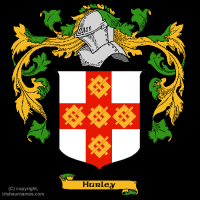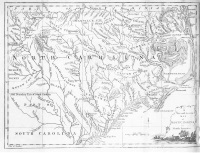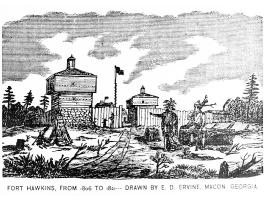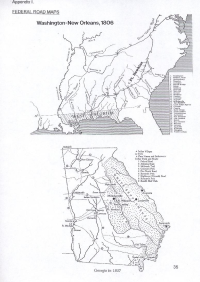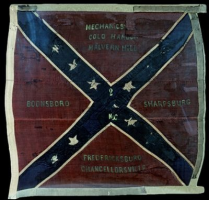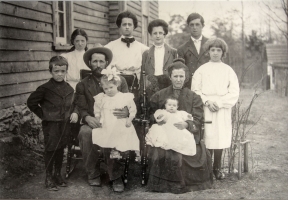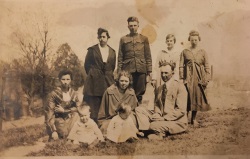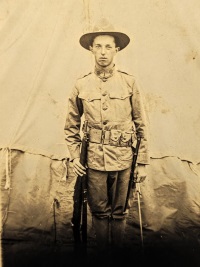1645
New World Pioneers
Born in Ireland, and possible arrival in Virginia as a bondsman between 1654 and 1666. At the end of his servitude, (18 years) possibly transported to Talbot Count Maryland by William Frige aboard the 'Maryland Merchant' to help start a colony, arriving in 1676. Elizabeth is listed as widow and Executrix for Daniel Hurley on Bond dated June 4, 1706 in Annapolis, MD. 1
1.1 Daniel Hurley b. circa 1701 (Prince George county Maryland), d. Apr. 24, 1793.
.
1701
Daniel and his family lived along the Hensons branch of the Potomac river, and were members of the St. John's Episcopal Church, one of the 30 original parishes established in the new world by the Church of England. 2 Daniel is buried in St. John's Parrish Cometary, Prince George County Maryland.
Daniel received a Patent for land on Aug. 24, 1732, recorded in the land records of Prince George's county at Upper Marlboro. This land, known as part of "Weaver's Delight" is located on the south side of Henson's Branch. 1
Hensen Branch/Creek is a feeder stream near the mouth of Broad Creek at the Potomac River just a few miles south of the present day Woodrow Wilson Memorial Bridge (I-95) in Washington DC.
1.1.2 Cornelius Hurley, b. circa 1730, d. circa 1788; m. Mary
| Salem Hurley, b. 1757 | |
| Barsheba Hurley, b. June 6, 1762; m. Dec. 11, 1782 John Darnall | |
| William Hurley, b. May 26, 1765 | |
| Rhoda Hurley, b. Nov. 15, 1767; m. Apr. 11, 1793 Samuel Taylor | |
| Joel Hurley, b. circa. 8, 1773 | |
1.1.3 Thomas Hurley, b. circa, 1735; m. Jane
1.1.4 Edmund Hurley, b. circa 1736, d. 1800; m. Rachael Fry, b 1740 (in Ireland)
1.1.5 William Hurley, b. circa 1739, d. 1799; m. Rachel. Migrated to Pennsylvania.
| Daniel Hurley | |
| John Hurley | |
| William Hurley | |
| Basil Hurley | |
| Mary Hurley | |
| Nathan Hurley, m. Susanna Stottlmier. Their daughter Rebecca m. Abraham Griffith and emigrated to Australia in 1855. |
St. John's Episcopal Church Fort Washington, Maryland, King George;s Parish
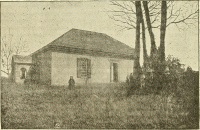
http://www.stjohnsbroadcreek.org/
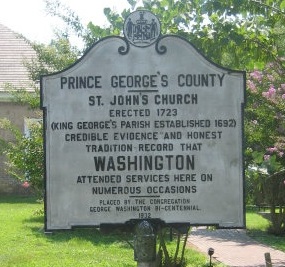
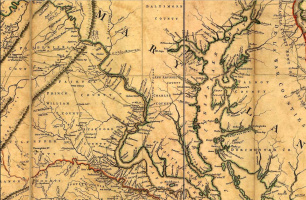
Map of the Potomac River, Virginia and Maryland area circa 1751. Click on map to enlarge. Broad Creek, which is fed from Hensens Branch is highlighted.
By the 1740s another road beside the Fall Line Road into the interior of Virginia and the Carolinas was needed. By 1748 the original trails were improved enough to be considered wagon roads. This set of trails came to be called the Upper Road or Piedmont Road and provided major access to interior farm lands. During the Revolutionary War these roads were important to both sides moving troops in the campaigns of the southern states. 8
Both the Upper Road, and the Fall Line Road ended at Macon, Georgia. In 1806 the federal government signed a treaty with the Creek Indians authorizing a "horse path" (mail route) through Indian land from Macon to New Orleans, Louisiana. The Creek Indians were postmasters along this extension to the west. 8
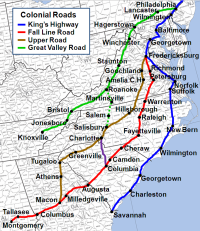
1736
On Feb. 15, 1775 Danial Hurley deeded a part of his lands called "Weavers Delight" and part of the tract called "Friend's Good Advice" to Edmund Hurley. Edmund acquired additional tracts of land; "Hurley's Lott" in 1762, and "Hurley's Fancy" in 1764. 1
Edmund and Rachael migrated to Anson County North Carolina, (now Montgomery County) between 1766 and 1773. Land records show he obtained 100 acres of land on Barnes Mill Creek from James Cotton in Anson Count North Carolina. Witness by Thomas Fry, Jr., Rachael's brother from Maryland. (land located on Millstone Mountain, near the Uwharrie River, in the Uwharrie National Forest, approximately 8 miles Northwest of Troy, NC).
Edmund would obtain land in Moore county near present day Carthage, NC, circa 1787 and apparently lived there for a time, and then returned to Montgomery county.
1.1.4.2 James Hurley, b. 1760
1.1.4.3 Amelia Lena Hurley, b. 1761
1.1.4.4 Joshua Hurley, b.May 20, 1762, d. 1841
1.1.4.5 Susanna Beane Hurley, b. circa 1766
1.1.4.6 Nancy Hurley, b. 1770 ; m. May 19, 1789 George Dent Canton
1.1.4.7 Daniel Hurley, b. circa 1771, d.; m. Mary Worrell, b. 1770
1.1.4.8 William Hurley, b. 1773, d. 1855
"... In the pioneer settlement of many lands, it is axiomatic that the first settlers get the best land.
And these early arrivals were highly competent to judge the productivity of the soil by taking note of the forest growth. Unfortunately for them, the biggest trees forested the best land, but this did not daunt them, even though the clearing for their fields was a Herculean task.
One of these fertile and desirable areas of Moore County lay in the Sandhills but was far from being sand land. This anomaly includes Lower Little River from about Thagard Lake upstream to about Black’s Mill and reaches about a mile up Wad’s Creek. Here the soil is clay with large rocks and widespread gravel beds. This area was early discovered and secured by grant.
The 300-acre tract entered by Thomas Wadsworth, later sold to Kenneth Black, and which became “Glendale,” the home of Maj. Alexander McLeod, lies athwart Wad’s Creek and the old Joel Road, is adjoined by other old grants. Wadsworth was the first settler in this area (1758) and was followed by John Pate (1767), John Wadsworth (1774) and Thomas Pate 1775). In 1792, Edmund Hurley came over from Montgomery County and secured a grant of 50 acres adjoining the Glendale and John Pate tracts. The late I. Haywood Caddell much later came into possession of this 500 acres, as well as other lands, and his house stood upon this tract.
It is not known when or if Hurley made his home here, but he did, however, then or later, put one William Clifton on the place, either as a tenant or an overseer. Later (before 1797), Clifton came into possession of this 50 acres, and in addition, the John Pate 200 acres mentioned above." 5
1771
1.1.4.7.2 Cornelius Hurley, b. circa 1796, d. 1855 ; m. June 25, 1818 Elizabeth C. Beane, b. 1804
1.1.4.7.3 Nancey Hurley, b. Aug. 29, 1800; m. Lockhart Fry
1.1.4.7.4 Freeman B. Hurley, b. Apr. 19, 1804, ; m. 1829 Rhoda Beamon, b. 1814
1.1.4.7.5 Mary Ann Hurley, b. May 13, 1805
1.1.4.7.6 Noah Hurley, b. 1808
1.1.4.7.7 Samuel Hurley, b. 1809
1.1.4.7.8 Daniel Wade Hurley, b. 1810
1.1.4.7.9 Joshua (Shad) Hurley, b. Apr. 11. 1812; m. 1st Lydia. 2nd Nov. 28, 1875 Margaret A. Strider
1.1.4.7.10 Thomas Hurley
From the Heritage of Montgomery County, North Carolina, 1981, by the Montgomery County Historical Society:
"... Daniel was said to have been a rugged individualist, and a typical backwoodsman of his time, living in the Uwharrie section of Montgomery county, North Carolina. He is said to have been a very good swimmer, and once reportedly swam the Narrows of the Yadkiin River near his home., winning a bet that he could not do so holding a jug of whiskey sloft in one hand. He made it, still holding the handle aloft, although the jug was broken along the way." 9
1796
1.1.4.7.2.2 Celia Hurley, b. circa 1826, d. 1902; m. May 8, 1848 Joseph Spencer Moore
1.1.4.7.2.3 Amistead Hurley, b. 1826; m. Apr. 20, 1850 Mary Ann Beaman
1.1.4.7.2.4 Cornelius Hurley II, b. Oct. 12, 1830, d. May 28, 1914; m. Jane DeBerry, daughter of Benjamin DeBerry. They lived in Wadesville, North Carolina.
1.1.4.7.2.5 Mary Hurley, b. circa 1830; m. Wilhelm Rommell (known as "Uncle John Brown" and lived in High Point, NC.
1.1.4.7.2.6 Beya Hurley, b. circa 1832
1.1.4.7.2.7 Polly A. Hurley, b. circa 1832
1.1.4.7.2.8 Daniel Wade Hurley, b. circa 1836, d. May 3, 1863; m. Nov. 26, 18759 Elizabeth P. Coggins. Daniel was a Confederate Soldier with the 2nd N.C. Regiment, Company A and was a drummer. He died at the Battle of Chancellorsville on May 3, 1863. 6 See below
1.1.4.7.2.9 Nathan Hurley, b. 1839, d. June 30. 1862. Nathan was Confederate Soldier, most likely with his brother in the 2nd NC. Regiment. He died at the battle of Cold Harbor. (note that sources report Nathan died June 1864, the Battle of Cold Harbor took place in June 1864.)
1.1.4.7.2.10 Barbara Elizabeth Hurley, b. circa 1842
1.1.4.7.2.11 Amanda Hurley, b. circa 1844; m. Ralph (Rafe) Mason
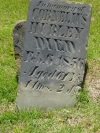
Cornelius Hurley
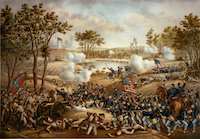
Battle of Cold Harbor
1821
1.1.4.7.2.2.2 Henry Taylor Hurley, b. Dec. 31, 1847, d. Oct. 8, 1934 ; m. Ruhama Virena Hinshaw. b. Oct. 12, 1846, d. May 21, 1922. Buried at New Salem Friends Cemetery Randolph Co. NC.
1.1.4.7.2.2.2 James M. Hurley, b. Oct. 14. 1849, d. Feb. 15, 1933; m. Mary Ellen Loflin Hiatt, b. Aug. 27, 1852, d. Oct. 15, 1905.
1.1.4.7.2.2.4 Daniel Wade Hurley, b. 1851, reportedly died as a young man.
1.1.4.7.2.2.5 Cornelius E. Hurley III, (aka 'Red Neil' for his red hair) b. Apr. 11, 1853, d. Jan. 20 1910 ; m. Flora McDonald. Coggins, b. Dec. 15, 1859, d. Aug. 23, 1929. daughter of George Coggins b. 1794 and Lucy Ann Hurley Coggins.
1.1.4.7.2.2.6 Jesse McB Hurley, b. circa 1855 ; m. Odon, lived on farm near Bennetsville, SC.
1.1.4.7.2.2.7 Nathan S. Hurley,(aka 'Doc') b. 1857 ; m. Jan, 19,1881 Laura C. Andrews, b. 1864. The family lived in Charlotte, NC.
1.1.4.7.2.2.8 Celia Ann Hurley, (aka 'Aunt Duck') b. May 24, 1859, d. Oct. 25, 1937; m. Thomas B. Coggins, b. Dec. 23, 1854 (son of of George Coggins b. 1794 and Lucy Ann Hurley Coggins), d. June 24, 1930
1.1.4.7.2.2.9 Oran A. Hurley, (aka 'Bud'), b. Jan. 15, 1861, d. Feb. 15, 1940 ; m. Sept. 29, 1886 Martha E. Beamon, daughter of Jack and Mary Beamon, b. Oct. 11, 1867, d. Feb. 5, 1971.
1.1.4.7.2.2.10 Mary Elizabeth F. Hurley, b. May 11, 1865, d. Feb. 17, 1936 ; m. Apr. 25, 1887 Griggin Schofield Beamon, b. Mar. 28, 1864, d. Jan 27, 1951.
1.1.4.7.2.2.11 Cicero Hurley, b. June 19, 1867, d. Apr. 9, 1941; m. Aug. 4, 1889 l,Emma Bell b. 1871.
From Vikki Bynum:
"... In two of my works on Southern Unionism, Unruly Women (1992), and Long
Shadow of the Civil War (2010), I wrote extensively about the effects of the
anti-slavery Wesleyan Methodist movement in creating an environment of fierce
anti-Confederate sentiment in the Randolph-Montgomery County area of North
Carolina during the Civil War. In Montgomery County, several Wesleyan families’
refusal to support the Confederacy tragically resulted in the vigilante murder
of three Hulin brothers by home guard soldiers.
The Hulins, Moores, and Hurleys became Wesleyans a full decade before the Civil War and were anti-slavery activists. A year before the war erupted, in March 1860, Hiram Hulin, Jesse Hulin, Nelson Hulin (sons of Hiram), William Hurley Sr., William Hurley Jr., and Spencer Moore (son of Valentine Moore) were charged alongside Daniel Wilson, a well-known anti-slavery leader from Guilford County, with circulating “seditious” anti-slavery materials.
Although I relied principally on court records, military records,
newspapers, and memoirs to tell the story of Unionism in this region of North
Carolina, I found two Wesleyan Methodist publications, Roy S. Nicholson’s
Wesleyan Methodism in the South (1933), and Mrs. E.W. Crooks’ Life of Rev. Adam
Crooks (1875), crucial to my ability to confirm the religious conversions of
the above Montgomery County families.
In the following essay, I draw from both these works. As “in house”
publications, they reflect the perspective of the Wesleyan Movement, yet, in
combination with primary sources, they leave no doubt of the religious ideology
that led the Hulins, Moores, Hurleys,
and others to oppose slavery and the Confederate Cause. "
Vikki Bynum, Moderator
Southerners Against Slavery: Wesleyan Methodists in Montgomery County,
North Carolina
In 1850, despite violent opposition to Wesleyan preachers by pro-slavery mobs, Crooks prepared to preach in Montgomery County at the invitation of members of Lane’s Chapel and Lovejoy Chapel. Twice, he was warned by letter to cancel those plans. The first letter, signed by “Many Citizens” from Montgomery and neighboring Stanly Counties, accused Crooks of preying upon the minds of the weak and innocent, inducing them to believe that slave-holding is not only an oppression to the slaves, but to all those who do not hold slaves. The slaves hereabout are in much better condition than their masters or other citizens. Your doctrine, if carried out, would bring down vengeance upon the heads of your followers by amalgamation and otherwise.
A second letter from Montgomery County, dated 27 December 1850 and signed by eleven people, demanded again that Crooks leave the state. Crooks did not answer the letter, but traveled to Montgomery County as planned, where he stayed at the home of Valentine Moore and prepared, in February 1851, to preach at Lovejoy Chapel, located about a mile from Moore’s home.
Then, the anti-Crooks faction rose to forcibly remove Crooks from
Lovejoy Chapel, at which point Orrin Hulin cried out, ...Men, take notice of who takes
hold of that man by violence.
As the mob approached Crooks, William
Hurley stepped before it and called out,
Mrs. Crooks further described how several men forced Crooks into a buggy as Orrin Hulin once again called on Crooks’ supporters to “take notice of who forces that man into that buggy.” Several of Crooks’ supporters followed the buggy on foot to the home of one of the slaveholders. There, over dinner, pro- and anti-slavery factions, including Crooks, argued over slavery. Sheriff Aaron Sanders, a member of the Methodist Episcopal Church and part of the mob that accosted Crooks, was present. So also was William Hurley, Crooks’ defender, who proclaimed himself “ever opposed” to slavery.
“Well, if that is your principle you ought to leave the state,” advised the same man, advice to which Hurley strenuously objected:
As the argument heated up, another slaveholder advised the mob to
“serve him [Hurley] as we do Crooks.” But William
Hurley appeared to be forgotten after four magistrates ordered Sheriff
Sanders to deliver Adam Crooks to the jail.
After being locked up, Crooks was lectured by his captors on the need
to abandon his plan to preach in Montgomery County. Exhibiting the common
social superiority that slaveholders felt toward non slaveholders, they assured
Crooks that the folks who had invited him to speak (members from the Moore,
Hulin, and Hurley families) were the “very dregs of the county,” while “those
who are against you,” (slaveholders), “are the best men of the county.”
Finally and reluctantly, Adam Crooks agreed to leave Montgomery County
and was accordingly released from jail. He then returned to the home of
Valentine Moore to say his goodbyes. While there, he reported, Valentine’s
daughter Caroline (who would soon marry Hiram Hulin’s son, Jesse) announced to
Crooks that she was leaving the Methodist Episcopal Church and joining with the
Wesleyans.
Slaveholders had prevented Adam Crooks from preaching in their county, but they had failed to prevent the successful birth of Wesleyan Methodism in their community. Battle lines would be redrawn during the Civil War, in a brutal inner war that would pit the same Sheriff Aaron Sanders against the same community of dissenters. 10
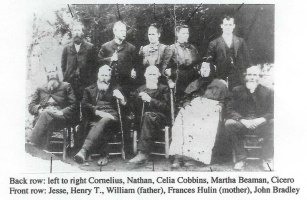
William Beane Hurley and Family ~ early 1900's
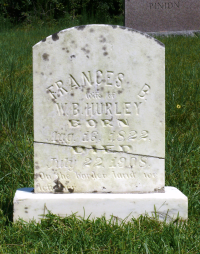
Francis B. Hurley
Mt. Olivet Methodist Church, Troy, NC
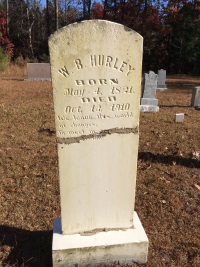
William B. Hurley
Mt. Olivet Methodist Church, Troy, NC
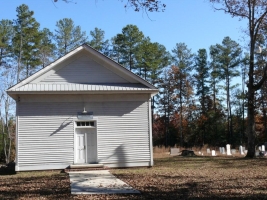
Mt. Olivet Methodist Church - Troy, NC
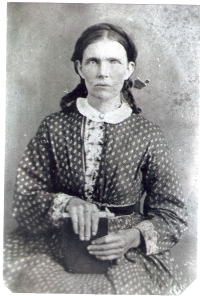
Caroline Moore Hulin
1861
Martha attend a one room schoolhouse known as the Old Beamon School, and later one known as Shiloh School near Troy, NC.
1.1.4.7.2.2.9.2 Lennie Hurley, b. Feb. 1892; m. Raymond Loy
1.1.4.7.2.2.9.3. Jewell Hurley, b. Aug. 1894; m. Erwin Walker
1.1.4.7.2.2.9.4 Mary Francis Hurley, b. Feb. 4, 1896, d. July 18, 1990
1.1.4.7.2.2.9.5 Gladys Hurley, b. Apr. 1899, d. 1963 ;m. Roy R. Shoe
1.1.4.7.2.2.9.6 DeWitt T. Hurley, b. June 21, c. 1900, d. Dec. 30, 1971; m. Nanny
1.1.4.7.2.2.9.7 Jessie Beamon Hurley, b. c. 1907; m. Lacy Thomas
1.1.4.7.2.2.9.8 Evelyn Hurley, b. 1909; m. Clyde Campbell
Back row, left to right: Mary, Jewell, Lennie, Charles.
Front Row, left to right: DeWitt, Oran, Jessie, Evelyn, Martha.
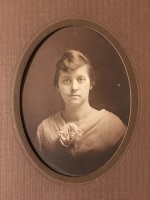 |
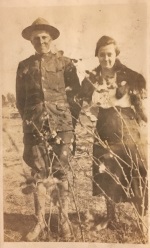 |
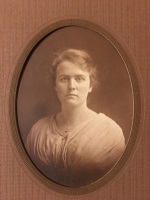 |
| Jewell Hurley circa 1916 |
Ewrin & Jewel Walker circa 1918 |
Gladys Hurley circa 1921 |
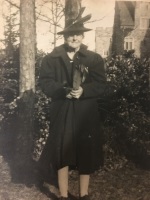 |
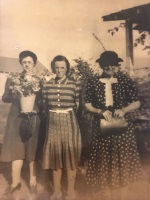 |
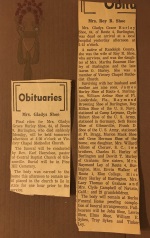 |
| Martha Beamon Hurley Holy Comforter Episcopal Church, Burlington, NC |
Mary, Jewel & Martha Hurley |
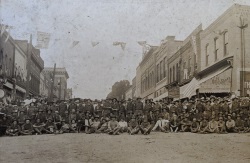
Company A, 120th Infantry Regiment
North Carlona Army National Guard
Burlington, NC 1909
(Charles Hurley in picture)
1890
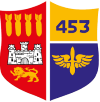
453rd Bomb Group
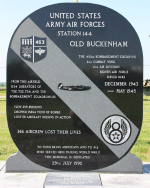
Memorial at Old Buckenham RAF Airfield
Notes from Richard Frobes, navigator who survived "...our aircraft, B-24 ('Flak Hack'), after being shot up over a bombing run to Karlsrugh, Germany, was ditched in North Sea. 4 crew members survived, 5 died. Crew were rescued after spending seven hours in a dinghy in 30 ft. waves. Lt. Forbes used a small hand mirror to catch the sun's rays, and the signal was picked up by a passing bomber who then relayed the message to British air/sea rescue. They were picked up around 10 o'clock at night. He had completed 14 missions."12
1.1.4.7.2.2.9.1.2 Manley Banks Hurley, b. Feb. 3, 1921, d. Oct. 15, 1996 ; m. Sept. 11, 1948, Pauline Artle Welch, b. Sept. 1, 1930, d. Sept. 15, 2013. Banks served in the Army from Sept. 1, 1942 until May, 1946. He served as an ambulance driver in France. Banks and Polly were married in York, SC by a Baptist minister that had been out plowing.
The family lived in Glencoe, NC and were members of the Glencoe Baptist Church, where they were all baptized on Sept. 4, 1930. They lived and worked in Glencoe for 42 years, their home still stands, the 3rd house on the east side of Front St. in the old Glencoe Mill village. 11 Charles and Minnie both worked as weavers in the mill. They moved to 410 Lakeside Ave. Burlington, NC sometime in the late 1950's. Charles worked for more than 50 years in the textile industry, then worked another 19 years as the crossing guard for the Blessed Sacrament Catholic School on Davis Street in Burlington.
Minnie's father, Man Marshall was the mill superintendent for forty years and lived on a one acre plot at the northeastern end of Glencoe, that he purchased from James H. Holt in 1899. An historic marker was placed near the old home site in 2010.
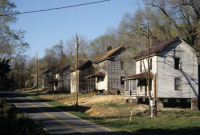 | 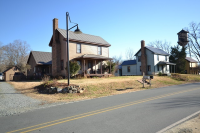 | 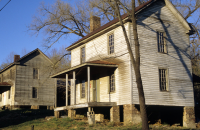 |
| Front Street Glencoe circa 1990's | Homes prior to heritage site renovations | |
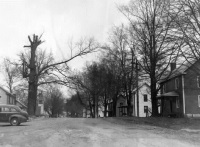 Front Street circa 1945 | 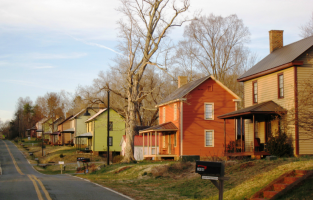 | 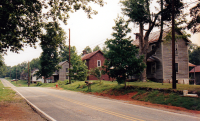 Hurley Home (red) circa 1975 |
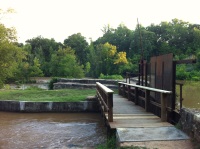 Mill race from Haw River | 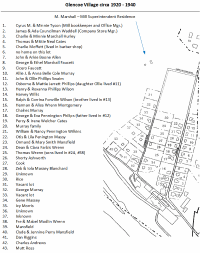 http://www.glencoenc.com/library/wholived.htm |
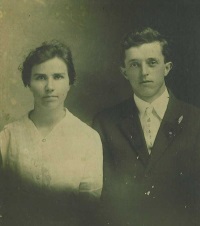
Minnie & Charles - circa 1916
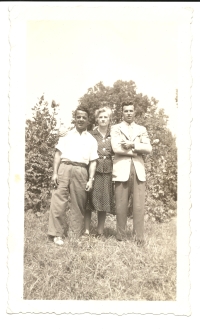
Banks, Minnie and Charles
late 1930's
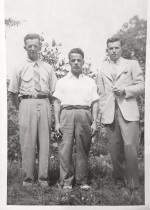
Charles, Banks and Charles
late 1930's
Banks & Charles
circa 1943
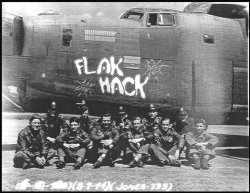
B-24 'Flack Hack'
last mission of prior crew, Aug. 1944
1921
1.1.4.7.2.2.9.1.2.2 Vicky Hurley, b. Oct. 1, 1950
1.1.4.7.2.2.9.1.2.3 Manley Banks Hurley Jr., b. Mar. 18, 1952
1.1.4.7.2.2.9.1.2.4 Pamela Sue Hurley, b. Oct. 19, 1953
1.1.4.7.2.2.9.1.2.5 Charles Marshall Hurley, b. Feb. 29, 1956
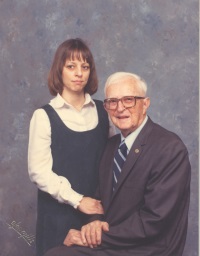
Becky Lynn Hurley & Charles Hubert Hurley
early 1980's
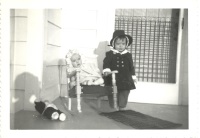 | ||
| Vicky & Becky Hurley - 1951 | Four Generations Martha, Charles, Manley Jr. Manley Sr. | |
